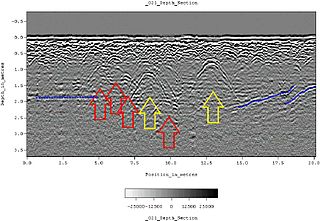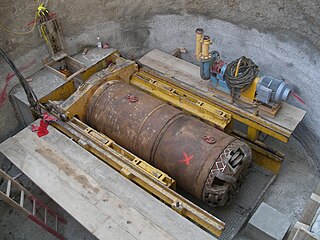
A sanitary sewer is an underground pipe or tunnel system for transporting sewage from houses and commercial buildings to a sewage treatment plant or disposal. Sanitary sewers are a type of gravity sewer and are part of an overall system called a "sewage system" or sewerage. Sanitary sewers serving industrial areas may also carry industrial wastewater. In municipalities served by sanitary sewers, separate storm drains may convey surface runoff directly to surface waters. An advantage of sanitary sewer systems is that they avoid combined sewer overflows. Sanitary sewers are typically much smaller in diameter than combined sewers which also transport urban runoff. Backups of raw sewage can occur if excessive stormwater inflow or groundwater infiltration occurs due to leaking joints, defective pipes etc. in aging infrastructure.

A tunnel boring machine (TBM), also known as a "mole", is a machine used to excavate tunnels. Tunnels are excavated through hard rock, wet or dry soil, or sand, each of which requires specialized technology.

Directional drilling is the practice of drilling non-vertical bores. It can be broken down into four main groups: oilfield directional drilling, utility installation directional drilling, directional boring, and surface in seam (SIS), which horizontally intersects a vertical bore target to extract coal bed methane.

Ground-penetrating radar (GPR) is a geophysical method that uses radar pulses to image the subsurface. It is a non-intrusive method of surveying the sub-surface to investigate underground utilities such as concrete, asphalt, metals, pipes, cables or masonry. This nondestructive method uses electromagnetic radiation in the microwave band of the radio spectrum, and detects the reflected signals from subsurface structures. GPR can have applications in a variety of media, including rock, soil, ice, fresh water, pavements and structures. In the right conditions, practitioners can use GPR to detect subsurface objects, changes in material properties, and voids and cracks.
The New Austrian tunneling method (NATM), also known as the sequential excavation method (SEM) or sprayed concrete lining method (SCL), is a method of modern tunnel design and construction employing sophisticated monitoring to optimize various wall reinforcement techniques based on the type of rock encountered as tunneling progresses. This technique first gained attention in the 1960s based on the work of Ladislaus von Rabcewicz, Leopold Müller, and Franz Pacher between 1957 and 1965 in Austria. The name NATM was intended to distinguish it from earlier methods, with its economic advantage of employing inherent geological strength available in the surrounding rock mass to stabilize the tunnel wherever possible rather than reinforcing the entire tunnel.

Shaft mining or shaft sinking is the action of excavating a mine shaft from the top down, where there is initially no access to the bottom. Shallow shafts, typically sunk for civil engineering projects, differ greatly in execution method from deep shafts, typically sunk for mining projects.
Pipe bursting is a trenchless method of replacing buried pipelines without the need for a traditional construction trench. "Launching and receiving pits" replace the trench needed by conventional pipe-laying.

Microtunneling or microtunnelling is a tunnel construction technique used to construct utility tunnels from approximately 0.5–4 m in diameter. Because of their small diameter, it is not possible to have an operator driving the tunneling machine, so they have to be remotely operated.
Directional boring, also referred to as horizontal directional drilling (HDD), is a minimal impact trenchless method of installing underground utilities such as pipe, conduit, or cables in a relatively shallow arc or radius along a prescribed underground path using a surface-launched drilling rig. Directional boring offers significant environmental advantages over traditional cut and cover pipeline/utility installations. The technique is routinely used when conventional trenching or excavating is not practical or when minimal surface disturbance is required.

A deep foundation is a type of foundation that transfers building loads to the earth farther down from the surface than a shallow foundation does to a subsurface layer or a range of depths. A pile or piling is a vertical structural element of a deep foundation, driven or drilled deep into the ground at the building site.

A cured-in-place pipe (CIPP) is a trenchless rehabilitation method used to repair existing pipelines. It is a jointless, seamless pipe lining within an existing pipe. As one of the most widely used rehabilitation methods, CIPP has applications in sewer, water, gas, chemical and district heating pipelines ranging in diameter from 0.1 to 2.8 meters.
Pipe ramming is a trenchless method for installation of steel pipes and casings. Distances of 30 m or more and over 500 mm in diameter are common, although the method can be used for much longer and larger installations. The method is useful for pipe and casing installations under railway lines and roads, where other trenchless methods could cause subsidence or heaving. The majority of installations are horizontal, although the method can be used for vertical installations.
Insituform Technologies, Inc. is a worldwide provider of trenchless technologies for gravity and pressure pipelines. Insituform is a subsidiary of Aegion Corporation..
Sliplining is a technique for repairing leaks or restoring structural stability to an existing pipeline. It involves installing a smaller, "carrier pipe" into a larger "host pipe", grouting the annular space between the two pipes, and sealing the ends. Sliplining has been used since the 1940s.
Michels Corporation is a family owned and operated energy and infrastructure construction company. Headquartered in Brownsville, WI, where it was established in 1959, Michels is one of the largest contractors in North America. It performs work throughout the world.

The East Side Big Pipe is a large sewer line and tunnel in Portland in the U.S. state of Oregon. It is part of a combined sewer system of pipes, sumps, drains, pumps, and other infrastructure that transports sewage and stormwater run-off to the city's Columbia Boulevard Wastewater Treatment Plant. The East Side Big Pipe project, begun in 2006 and finished in 2011, was the largest of a 20-year series of projects designed to nearly eliminate combined sewer overflows (CSO)s into the Willamette River and the Columbia Slough. The combined projects were completed on time, and they reduced CSOs into the river by 94 percent and into the slough by more than 99 percent.

Tunnels are dug in types of materials varying from soft clay to hard rock. The method of tunnel construction depends on such factors as the ground conditions, the ground water conditions, the length and diameter of the tunnel drive, the depth of the tunnel, the logistics of supporting the tunnel excavation, the final use and shape of the tunnel and appropriate risk management. Tunnel construction is a subset of underground construction.
Sprayed in place pipe (SIPP) technologies is a trench-less rehabilitation method used to repair existing pipelines, that involves a robotic lining system that develops and manufactures proprietary lining polymeric. SIPP is a jointless, seamless, pipe with in a pipe with the capability to rehabilitate pipes ranging in diameter of .1 to 2.8 meters. SIPP can be applied in water, sewer, gas, and chemical pipelines.
TT Technologies is a construction equipment manufacturer producing microtunneling and trenchless products.










